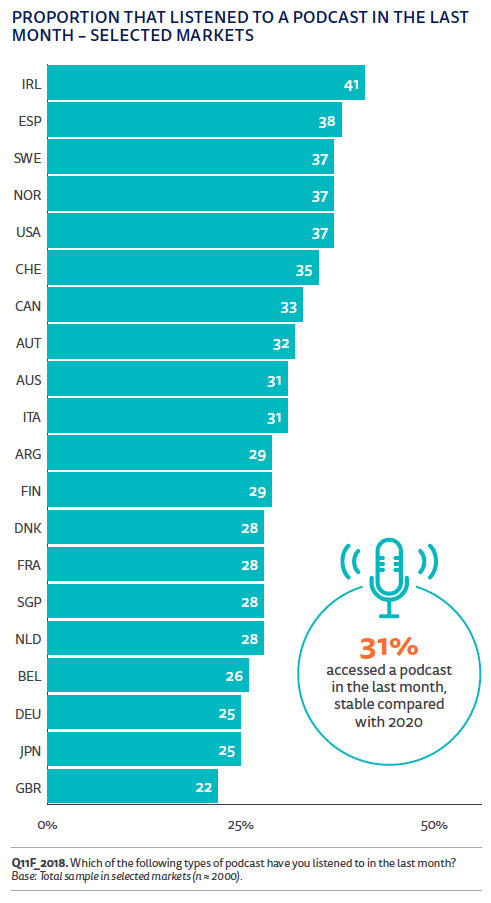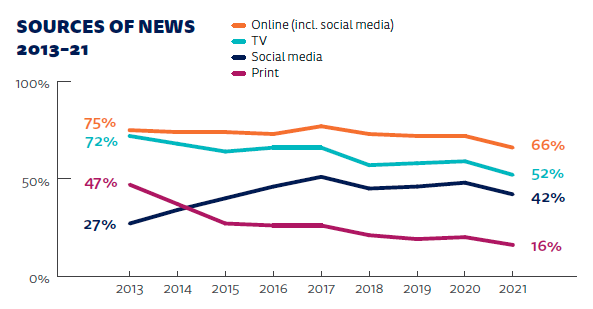
What the Digital News Report 2021 means for your audio strategy
Audience habits and opportunities for newsrooms
The Digital News Report, the latest edition of which was published at the end of June, is a must read for anyone who wants to understand the behaviors of online news consumers.
Now in its tenth year, the annual study from the Reuters Institute for the Study of Journalism (RISJ) now features insights from 46 different countries and 92,000 respondents.
As in previous years, the report offers analysis at a country and continental level, as well as cross-cutting issues such as paying for news, gateways to content and trust in media.
Clocking in at 164 pages, and accompanied by a wealth of other resources, including a 192 page slide deck, there’s a lot of data and analysis to wade through.
WIth that in mind, here’s a summary of the key takeaways through the lens of audio. The report identifies some key trends in the space, as well as other insights which have implications for audio strategies at newsrooms large and small alike.
1. COVID hasn’t shifted the podcast needle
At the start of the pandemic, there was a rush by newsrooms to create new pandemic products, a trend that included podcasts and newsletters.
“Podcasts have become a key part of many lockdown routines,” the report notes, “with more consumption at home,” but “the net impact on consumption seems to have been neutral.”
One reason for this, the author says, is “disruption to the daily commute, traditionally a key time for listening.” That’s certainly true for my own listening, but it’s worth noting that in the U.S. research has historically suggested that the bulk of podcast listening — even pre-COVID — was done at home.
Implication: Podcasting hasn’t really changed during the pandemic. Podcast advertising may be on the rise, but reach looks pretty similar to before the COVID-crisis.

2. YouTube is the USA’s most popular podcasting platform
Yes, you read that correctly. In the States, the most popular platform for podcasts (based on a sample of 2,001 digital news consumers) is YouTube.
One reason for this, the report contends, is that “the growth of video podcasting, accentuated by the use of tools like Zoom during the pandemic, is opening an even wider range of options for distribution.”
With podcast conversations recorded over Zoom, or other video calling apps, it’s easier than ever to record – and distribute – these discussions on video platforms. Zoom allows you to share live calls on YouTube and Facebook, while the audio can also be downloaded separately and uploaded to SoundCloud, iTunes et al.
The YouTube podcasting trend isn’t a unique bi-product of COVID. Podcasters like David Axelrod, Joe Rogan and others, have long distributed their shows on the video platform, using a simple studio setup. Interestingly, among students in my audio class last term, several mentioned that they only consumed podcasts via YouTube.
Implication: If YouTube isn’t already part of your audio distribution strategy, then data from the Digital News Report suggests that it really should be.

3. Lack of time is the biggest barrier to podcast consumption
When it comes to the main reasons why people don’t listen to podcasts, in the U.S. this is led by not having enough time (20%), lack of unique content (18%), length (12%) and having to listen “via a mobile phone or headphones” (12%).
The takeaways of this for newsrooms, would seem to focus on addressing issues of length (“podcasts are too long”) — which may well also address issues of not having time to listen.
Similarly, the editorial proposition is also really important. In my previous column, I recommended that newsrooms use audio as a means to allow audiences to “peek behind the curtain.” Discussions with journalists about “the story behind the story,” or insights into a paper’s editorial process, are seldom replicated in print.
As a result, this type of audio offers audiences something unique, and addresses a key barrier to consumption highlighted in the report. Distribution on desktop friendly platforms – like YouTube, SoundCloud and others — and not just mobile-only apps, is another important consideration.
Implication: Many podcasts feel overlong and self-indulgent. Shorter, sharper, material may work better. At the same time, your audio can’t just retread material found elsewhere, it needs to offer something different and fresh.

4. Podcasting can be a plank in your subscription strategies
One of the interesting things about this annual report is the ability to track trends over time. Many of these are quite sobering.
For example, traditional channels like TV and Print have endured precipitous falls in terms of their popularity as sources among those who also consume the news digitally. Since 2013, print’s audience has dropped by nearly two-thirds, while TV is down by over a quarter.

Alongside this, we have witnessed a small, yet steady, rise in the number of digital news consumers who are willing to pay for content.
Nonetheless, these numbers are still quite small. Just over one in five (21%) of digital news consumers pay for online news, up from 9% in 2016. The average age of those with an on-going subscription is 50-55. Just under a quarter (23%) of subscribers pay for local titles.
Because of this, the study notes, podcasts “are of particular interest to publishers because they attract younger and more affluent users that are highly sought by advertisers – and are potentially the next generation of subscribers.”
Implication: Audio and podcasts can be both a gateway for building loyalty and gaining subscribers as well as a means to offer subscriber-only content, which may help with retention and demonstrating value.
5. There are local media content gaps audio could help fill
The report reminds us that audiences (even if they don’t pay for it) do value local news.
Local information related to the pandemic, as well as weather, politics and crime news, were the most popular content categories in most markets. “Newspapers are also valued as a place for publishing formal announcements such as births and deaths,” the authors remind us. “But for other topics,” they observe, “alternative sources tend to be preferred.”
In particular, information about shops and restaurants (49%), local services (47%), or things
to do in the area (46%), tends to be sourced from social media and search; and there is a perception that these are better sources for these topics too.
Implication: Areas where local news outlets are seen as lagging behind other media could be a great space for audio content — especially if that also links back to your other material from on these subjects that audiences don’t necessarily know about.
